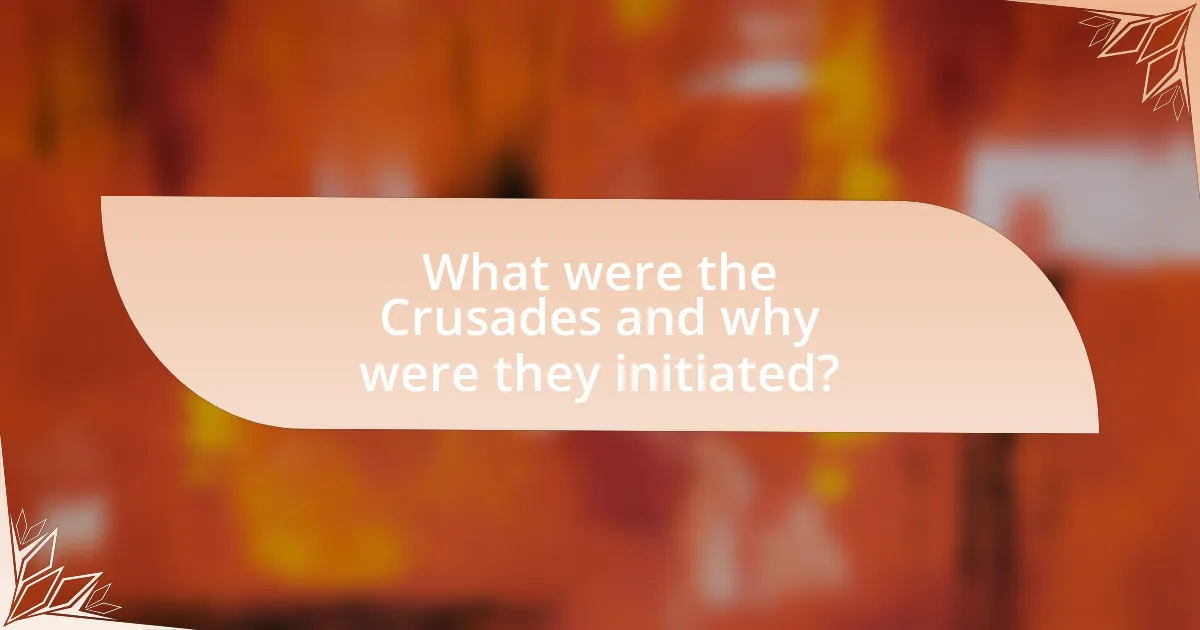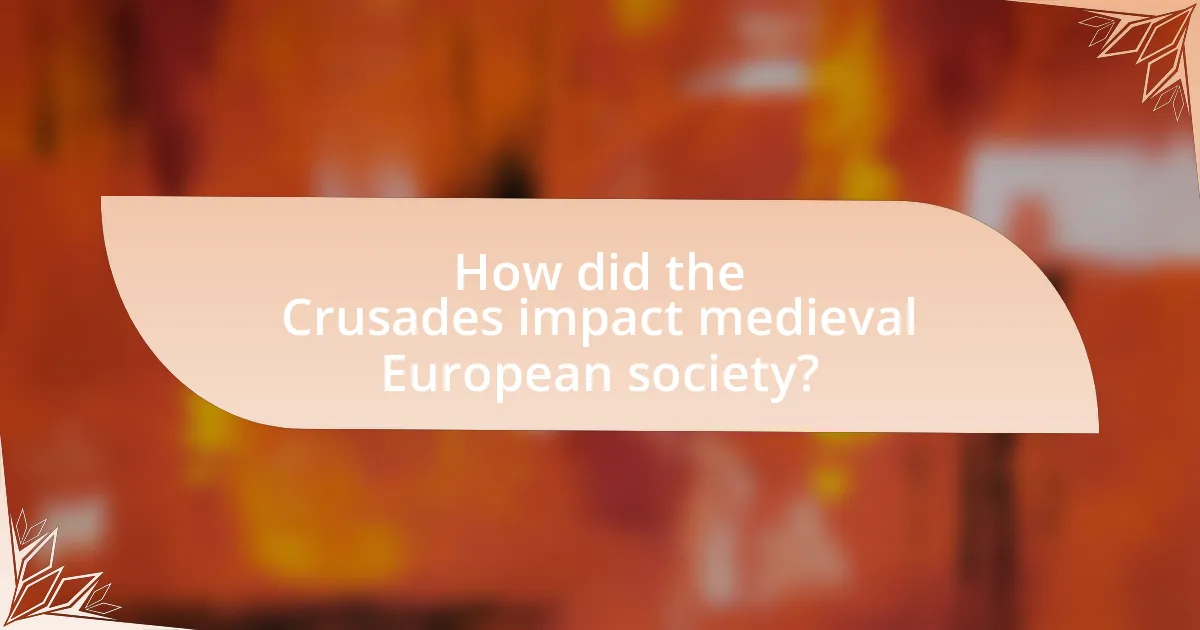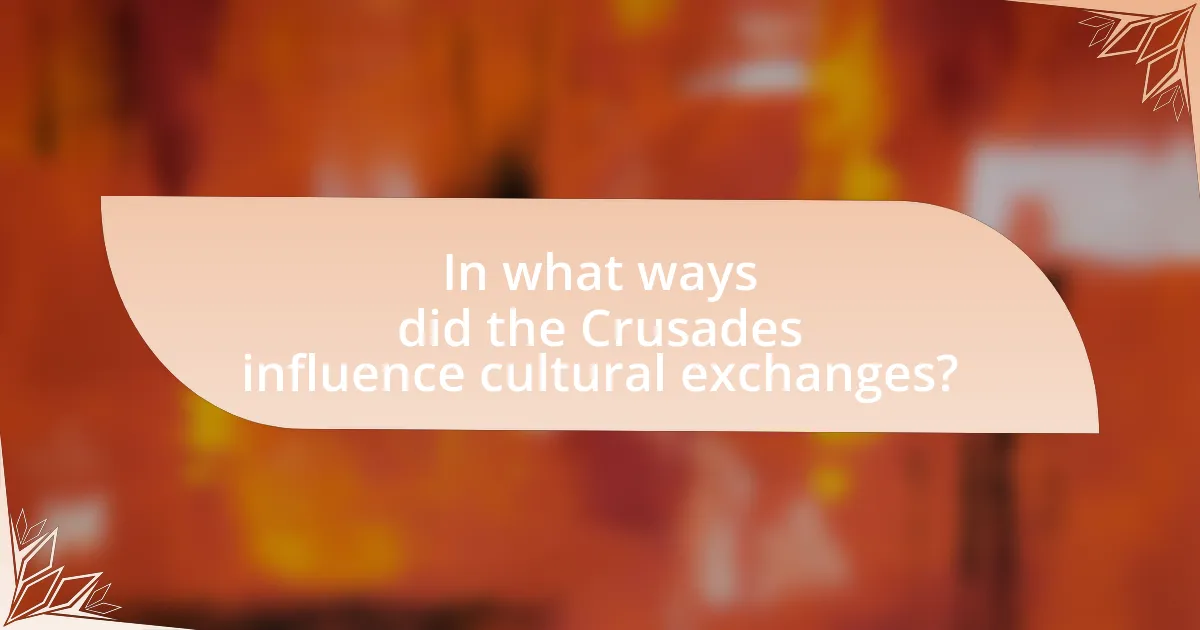The Crusades were a series of religious wars initiated by European Christians between the 11th and 13th centuries, primarily aimed at reclaiming Jerusalem and other holy sites from Muslim control. Motivated by a combination of religious fervor, political ambitions, and the desire for territorial expansion, these military campaigns significantly influenced medieval European society. Key players included European monarchs, the Papacy, and various military leaders, whose involvement reshaped political dynamics and facilitated cultural exchanges. The Crusades also led to economic growth, the rise of trade routes, and social changes, including shifts in the feudal system and the status of women. Overall, the Crusades played a crucial role in transforming the social, economic, and political landscape of medieval Europe.

What were the Crusades and why were they initiated?
The Crusades were a series of religious wars initiated by European Christians, primarily between the 11th and 13th centuries, aimed at reclaiming Jerusalem and other holy sites in the Middle East from Muslim control. The primary motivation for these military campaigns was the desire to secure access to sacred Christian locations, particularly Jerusalem, which was seen as vital for Christian pilgrimage and worship. Additionally, the Crusades were influenced by a mix of religious fervor, the promise of spiritual rewards, and political factors, including the desire to expand territorial control and influence in the region. Historical records indicate that the First Crusade began in 1096, following Pope Urban II’s call to arms at the Council of Clermont, where he urged Christians to assist the Byzantine Empire against Muslim advances and reclaim the Holy Land.
What were the main objectives of the Crusades?
The main objectives of the Crusades were to reclaim Jerusalem and the Holy Land from Muslim control, secure safe passage for Christian pilgrims, and expand Christian territories. The First Crusade, initiated in 1096, aimed specifically at capturing Jerusalem, which was achieved in 1099. Subsequent Crusades sought to maintain Christian dominance in the region and respond to perceived threats from Muslim forces. The Crusades also served to strengthen the authority of the Papacy and promote Christian unity against a common enemy, as evidenced by the widespread mobilization of European knights and nobles under papal encouragement.
How did religious motivations influence the Crusades?
Religious motivations were a primary driving force behind the Crusades, as they were framed as holy wars to reclaim Jerusalem and other sacred sites from Muslim control. The Catholic Church, particularly under Pope Urban II, called for the First Crusade in 1095, emphasizing the spiritual rewards, such as indulgences, for those who participated. This religious fervor mobilized thousands of knights and commoners, who believed they were fulfilling God’s will and securing their salvation through military action. The Crusades also led to the establishment of religious orders, such as the Knights Templar, which further intertwined military and religious objectives, reinforcing the idea that warfare could be a form of piety.
What role did political factors play in the initiation of the Crusades?
Political factors were crucial in the initiation of the Crusades, primarily driven by the desire of European leaders to expand their territories and influence. The call for the First Crusade in 1095 by Pope Urban II was motivated by the need to unite Christendom against a common enemy, the Seljuk Turks, who had captured Jerusalem. This unification served both religious and political purposes, as it aimed to strengthen the papacy’s authority and provide a means for European nobles to gain land and prestige. Additionally, the political instability in Europe, characterized by feudal conflicts and the need for knights to seek glory and wealth, further fueled the Crusades. Historical records indicate that many nobles saw participation in the Crusades as an opportunity to assert their power and gain new territories, thus intertwining political ambitions with religious fervor.
Who were the key players involved in the Crusades?
The key players involved in the Crusades included European monarchs, military leaders, and religious figures. Notable monarchs were Richard the Lionheart of England, who led the Third Crusade, and Saladin, the Muslim leader who opposed him and recaptured Jerusalem in 1187. Other significant figures included Pope Urban II, who initiated the First Crusade in 1095, and various knights and nobles from across Europe who participated in these military campaigns. The involvement of these players significantly influenced the political and religious landscape of medieval Europe, as the Crusades led to increased trade, cultural exchanges, and shifts in power dynamics between Christians and Muslims.
What were the roles of the Pope and the Church during the Crusades?
The Pope and the Church played pivotal roles during the Crusades by providing spiritual justification and mobilizing support for the military campaigns. The Pope, particularly Urban II, initiated the First Crusade in 1095, calling for Christians to reclaim the Holy Land from Muslim control, which was framed as a sacred duty. The Church facilitated the organization of the Crusades, offering indulgences to participants, which promised forgiveness of sins, thereby encouraging many to join the efforts. Additionally, the Church sought to unify Christendom under its authority, using the Crusades as a means to strengthen its influence and diminish internal conflicts among European states. Historical records indicate that the Crusades significantly increased the Church’s power and wealth, as it gained land and resources through the campaigns.
How did European monarchs contribute to the Crusades?
European monarchs significantly contributed to the Crusades by mobilizing military forces and resources to support the campaigns aimed at reclaiming the Holy Land. Monarchs such as Richard the Lionheart of England, Philip II of France, and Frederick I Barbarossa of the Holy Roman Empire led large armies during the Third Crusade (1189-1192), demonstrating their commitment to the cause. Their involvement not only provided the necessary manpower but also legitimized the Crusades as a noble endeavor, encouraging participation from knights and commoners alike. The financial backing and political influence of these monarchs were crucial in organizing the expeditions, as seen in the establishment of alliances and the collection of funds through taxation and donations.

How did the Crusades impact medieval European society?
The Crusades significantly transformed medieval European society by fostering increased trade, cultural exchange, and the rise of centralized monarchies. The influx of goods from the East, such as spices and textiles, stimulated economic growth and led to the establishment of trade routes, particularly through Italian city-states like Venice and Genoa. Additionally, the Crusades facilitated the transfer of knowledge, including advancements in science and philosophy from the Islamic world, which enriched European intellectual life. The military campaigns also contributed to the consolidation of power among European monarchs, as they gained prestige and resources, ultimately leading to stronger centralized states. Historical records indicate that the Crusades resulted in a more interconnected Europe, with lasting impacts on its social, economic, and political structures.
What were the social changes brought about by the Crusades?
The Crusades brought significant social changes, including the rise of a more interconnected European society and shifts in class structures. The increased contact with the East introduced new ideas, goods, and cultural exchanges, which fostered a sense of shared identity among Europeans. Additionally, the Crusades contributed to the decline of feudalism as many nobles sold their lands to fund their participation, leading to the growth of a merchant class and urban centers. This shift was evidenced by the establishment of trade routes and the emergence of towns, which became hubs of commerce and social interaction. Furthermore, the Crusades also altered the role of the Church, as it became more involved in political matters, influencing social hierarchies and power dynamics within Europe.
How did the Crusades affect the status of women in medieval Europe?
The Crusades significantly altered the status of women in medieval Europe by providing them with increased autonomy and opportunities during the absence of men who went to fight. As many men left for the Crusades, women often took on roles that were traditionally held by men, managing estates, businesses, and farms. This shift is evidenced by historical records indicating that women gained more economic power and social responsibility during this period, as they were required to oversee family affairs and maintain livelihoods in the absence of their husbands and fathers. Additionally, the Crusades led to the establishment of new social networks and interactions, which further empowered women by exposing them to different cultures and ideas, ultimately contributing to gradual changes in gender roles in medieval society.
What changes occurred in the feudal system as a result of the Crusades?
The Crusades led to significant changes in the feudal system, primarily by weakening the power of feudal lords and increasing the authority of monarchs. As nobles left to fight in the Crusades, their lands were often left in the hands of lesser vassals or were sold, which diminished the control of the traditional feudal hierarchy. This shift allowed kings to consolidate power and centralize authority, as they could reclaim lands and assert greater control over their realms. Additionally, the influx of wealth from the Crusades, through trade and plunder, enabled monarchs to strengthen their armies and reduce reliance on feudal levies, further altering the dynamics of feudal obligations and relationships.
What economic effects did the Crusades have on Europe?
The Crusades had significant economic effects on Europe, primarily by stimulating trade and commerce. The increased contact with the East introduced Europeans to new goods such as spices, silk, and other luxury items, leading to a rise in demand and the establishment of trade routes. Additionally, the Crusades contributed to the growth of merchant classes and the development of banking systems, as financial institutions emerged to support the increased trade activities. The influx of wealth from these trade interactions also facilitated urbanization, as towns and cities grew around trade hubs. Historical records indicate that by the end of the Crusades, European economies had become more interconnected, laying the groundwork for the later economic transformations of the Renaissance.
How did trade routes evolve due to the Crusades?
The Crusades significantly evolved trade routes by establishing new connections between Europe and the East. As European crusaders traveled to the Holy Land, they encountered and interacted with various cultures, leading to the exchange of goods such as spices, textiles, and precious metals. This interaction prompted the development of trade networks that linked Mediterranean ports with markets in Asia, enhancing the flow of commodities. Historical records indicate that cities like Venice and Genoa became major trade hubs as they capitalized on these new routes, facilitating commerce and cultural exchange. The increased demand for Eastern goods in Europe further stimulated trade, leading to the rise of merchant classes and the expansion of economic activity across the continent.
What impact did the Crusades have on the growth of towns and cities?
The Crusades significantly contributed to the growth of towns and cities in medieval Europe by stimulating trade and commerce. As Crusaders traveled to the Holy Land, they established trade routes that connected Europe with the Middle East, leading to increased economic activity. This influx of goods, such as spices, textiles, and precious metals, encouraged the development of marketplaces and urban centers. Additionally, the need for supplies and services for the Crusading armies led to the establishment of new settlements and the expansion of existing towns, as they became vital hubs for logistics and trade. Historical records indicate that cities like Venice and Genoa flourished during this period, becoming major maritime powers due to their strategic positions along these trade routes.

In what ways did the Crusades influence cultural exchanges?
The Crusades significantly influenced cultural exchanges by facilitating the transfer of knowledge, technology, and goods between the East and West. During the Crusades, European crusaders encountered advanced Islamic civilizations, leading to the introduction of new ideas in fields such as medicine, mathematics, and astronomy. For instance, the translation of Arabic texts into Latin made classical knowledge accessible to European scholars, which played a crucial role in the Renaissance. Additionally, the Crusades stimulated trade routes, allowing for the exchange of spices, textiles, and other commodities, which enriched European markets and lifestyles. The establishment of cultural interactions through these exchanges laid the groundwork for a more interconnected medieval world.
How did the Crusades facilitate the exchange of ideas and knowledge?
The Crusades facilitated the exchange of ideas and knowledge by creating direct contact between European and Middle Eastern cultures. This interaction led to the transfer of various intellectual advancements, including scientific, medical, and philosophical texts. For instance, the translation movement in the 12th century saw many Arabic works, such as those by Avicenna and Averroes, translated into Latin, significantly influencing European thought. Additionally, the Crusades introduced Europeans to new technologies, such as advanced military tactics and agricultural practices, which were adopted and adapted in medieval Europe. This cultural exchange was crucial in shaping the intellectual landscape of the time, ultimately contributing to the Renaissance.
What were the contributions of Islamic culture to European knowledge during the Crusades?
Islamic culture significantly contributed to European knowledge during the Crusades through the preservation and enhancement of classical texts, advancements in science and medicine, and the introduction of new philosophical ideas. Islamic scholars translated and preserved works from ancient Greece and Rome, which were largely lost to Europe during the early Middle Ages. Notably, figures such as Avicenna and Averroes made substantial contributions in fields like medicine and philosophy, influencing European thinkers such as Thomas Aquinas. Additionally, advancements in mathematics, particularly the introduction of Arabic numerals and algebra, transformed European mathematical practices. These contributions facilitated the Renaissance and laid the groundwork for modern science and philosophy in Europe.
How did the Crusades affect art and literature in medieval Europe?
The Crusades significantly influenced art and literature in medieval Europe by introducing new themes, styles, and cultural exchanges. The influx of Eastern artistic elements, such as Byzantine and Islamic motifs, enriched European artistic expression, leading to the development of new styles in architecture, painting, and decorative arts. For instance, the Gothic style emerged during this period, characterized by pointed arches and intricate sculptures, partly inspired by the architectural innovations observed in the Holy Land.
In literature, the Crusades inspired a wealth of narratives, including epic poems and romances that celebrated chivalric ideals and the valor of knights. Works like “The Song of Roland” and the “Chanson de geste” reflected the themes of heroism and religious fervor associated with the Crusades. Additionally, the translation of Arabic texts into Latin during this time facilitated the spread of knowledge, influencing European thought and literature. This cultural exchange not only transformed artistic practices but also shaped the literary landscape of medieval Europe, marking a significant shift in both domains.
What lessons can be learned from the significance of the Crusades?
The lessons learned from the significance of the Crusades include the impact of religious fervor on political and social structures, the complexities of cultural exchange, and the long-term consequences of conflict. The Crusades demonstrated how religious motivations could mobilize large groups, influencing the power dynamics in Europe and the Middle East. For instance, the First Crusade (1096-1099) resulted in the establishment of several Crusader states, altering territorial control and leading to centuries of conflict. Additionally, the interactions between Crusaders and Muslim societies facilitated cultural exchanges, including advancements in science, medicine, and philosophy, which were later transmitted back to Europe. The enduring legacy of the Crusades also highlights the importance of understanding historical narratives and their influence on contemporary religious and cultural identities.
How can the historical impact of the Crusades inform modern perspectives on conflict?
The historical impact of the Crusades can inform modern perspectives on conflict by illustrating the long-lasting effects of religious and cultural clashes. The Crusades, which spanned from the late 11th to the late 13th centuries, were characterized by military campaigns initiated by European Christians to reclaim the Holy Land from Muslim control. These conflicts not only reshaped territorial boundaries but also fostered deep-seated animosities and cultural exchanges that continue to influence contemporary geopolitical tensions. For instance, the legacy of the Crusades is evident in ongoing religious conflicts and the perception of the West in the Muslim world, as historical grievances from that era still resonate today. The Crusades serve as a case study in understanding how historical narratives and collective memories can perpetuate cycles of conflict, highlighting the importance of addressing historical injustices in modern diplomacy and conflict resolution.
What are the best practices for understanding the complexities of the Crusades in historical studies?
The best practices for understanding the complexities of the Crusades in historical studies include utilizing a multidisciplinary approach, critically analyzing primary sources, and considering diverse perspectives. A multidisciplinary approach integrates insights from history, theology, sociology, and archaeology, allowing for a more nuanced understanding of the motivations and impacts of the Crusades. Critical analysis of primary sources, such as chronicles and letters from the period, helps historians assess the reliability and bias of accounts, providing a clearer picture of events. Additionally, considering diverse perspectives, including those of different cultures and religions involved, enriches the analysis and highlights the multifaceted nature of the Crusades. For instance, examining both Christian and Muslim narratives reveals contrasting views on the same events, which is essential for a comprehensive understanding.